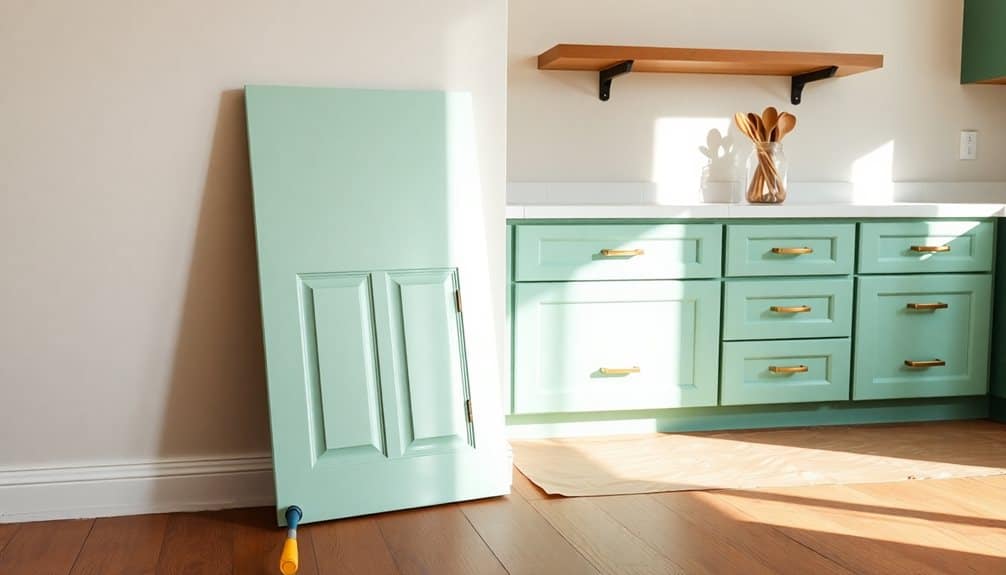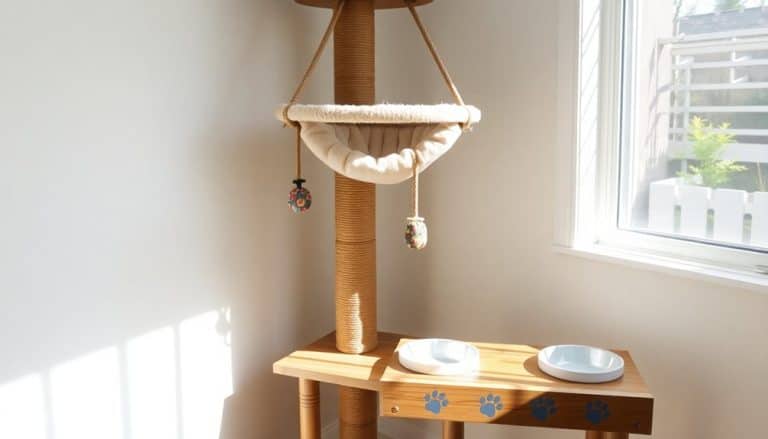This website contains affiliate links. Some products are gifted by the brand to test. As an Amazon Associate, I earn from qualifying purchases. The content on this website was created with the help of AI.
You can transform your kitchen with seven budget-friendly weekend projects. Start by updating cabinet hardware for instant visual impact, then refresh cabinets with a new paint job. Install under-cabinet LED lighting to enhance workspace functionality and ambiance. Create a modern look with peel-and-stick backsplash tiles, and add open shelving for stylish storage solutions. Revitalize dated countertops using epoxy coating techniques, and build a versatile rolling kitchen island for extra workspace. These DIY upgrades will cost under $1,000 combined, and each project packs serious value for your investment.
Key Takeaways
- Update cabinet hardware with new pulls and handles for an instant refresh that costs $2-15 per piece.
- Paint kitchen cabinets using oil-based primer and foam rollers for a dramatic transformation under $200.
- Install LED under-cabinet lighting to enhance workspace functionality and create ambient lighting.
- Create a peel-and-stick backsplash for an affordable alternative to ceramic tiles that’s easy to install.
- Build open shelving with 2×8 lumber and heavy-duty brackets to maximize storage space and visual appeal.
Update Cabinet Hardware
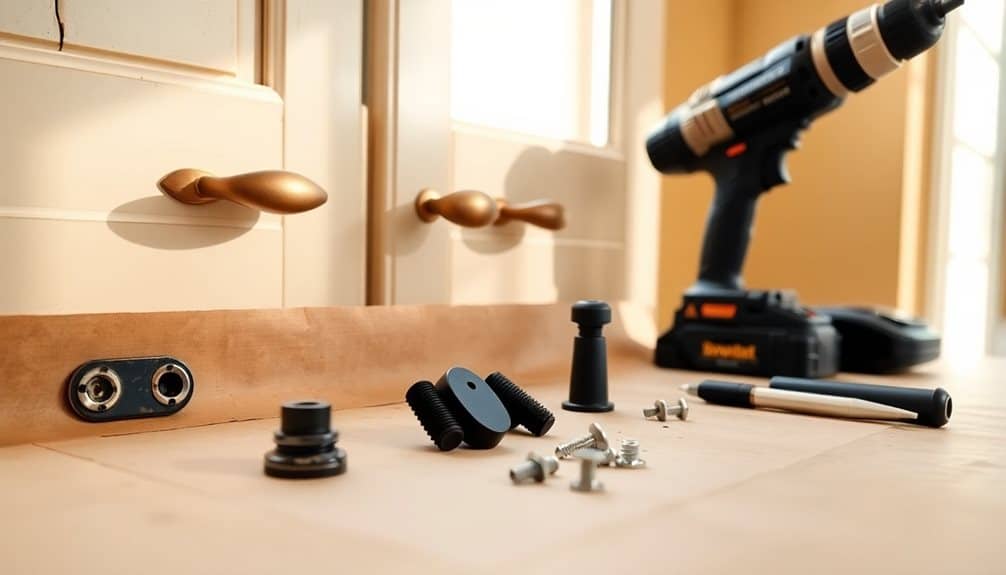
A gleaming set of cabinet pulls can transform your kitchen’s entire aesthetic. This hardware upgrade delivers maximum impact for minimal investment, typically running between $2-15 per piece. Before starting, you’ll need to determine your cabinet’s hole spacing by measuring the distance between existing screw holes, as most hardware comes in standard 3-inch or 96mm configurations.
To begin, remove the old hardware and fill any unnecessary holes with wood putty. Once dried, sand the areas smooth and touch up with matching paint or stain. You’ll want to create a template using painter’s tape and a level to guarantee consistent placement of new hardware. For doors without pre-drilled holes, use a cabinet hardware jig to assure precise drilling.
When installing, insert screws from the cabinet’s interior, securing them to the hardware’s exterior. If the new pulls have different screw lengths than your originals, you may need to trim them using bolt cutters. For best results, tighten pulls firmly but avoid over-torquing, which can crack the wood or strip the screws. Test each handle’s stability before moving to the next installation.
Paint Kitchen Cabinets

While new hardware makes an impact, painting your cabinets offers the most dramatic kitchen transformation for under $200. With proper preparation and technique, you’ll achieve professional-looking results that can last for years. Before starting, remove all hardware, doors, and drawers, labeling each piece’s location for easier reassembly.
For ideal results, follow these critical steps:
- Clean surfaces thoroughly with TSP (trisodium phosphate) to remove grease and grime
- Sand all surfaces with 120-grit sandpaper, followed by 220-grit for smoothness
- Apply oil-based primer specifically designed for cabinets, allowing full cure time
- Use foam rollers and high-quality brushes for streak-free application
- Apply 2-3 thin coats of paint rather than one thick coat, sanding between layers
Select paint specifically formulated for cabinets – either latex-based with enamel or oil-based for durability. You’ll want to work in a well-ventilated area and maintain consistent temperature and humidity levels throughout the project. Allow at least 24 hours of drying time between coats and a full week of curing before rehanging doors and resuming normal use. For optimal lighting while painting, consider installing LED string lights to ensure even coverage and spot any imperfections during the process.
Install Under-Cabinet Lighting
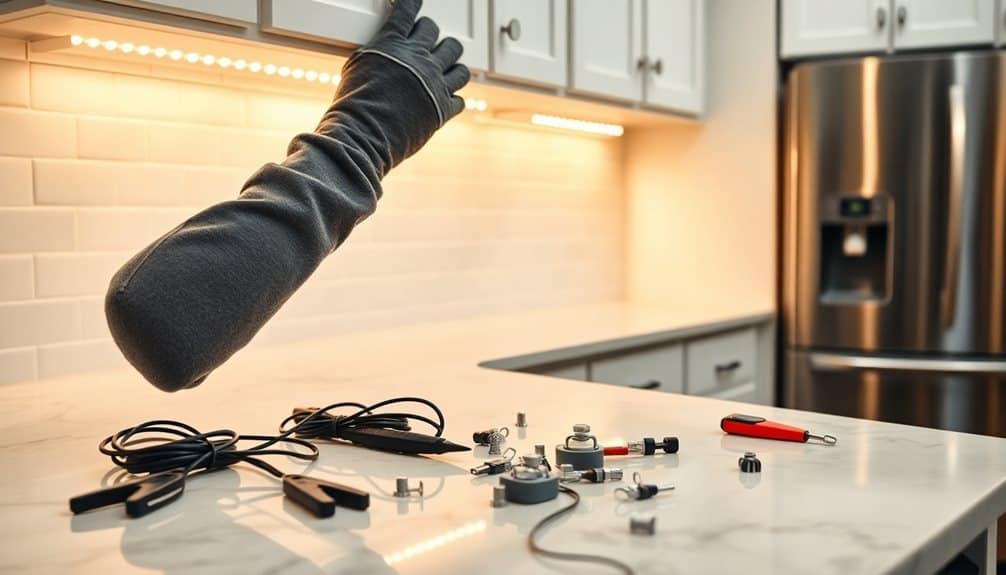
Under-cabinet lighting transforms your kitchen workspace with both functionality and ambiance. Today’s LED options provide energy-efficient illumination while requiring minimal installation expertise. You’ll need LED strips or puck lights, a power supply, mounting clips, and basic tools including a drill and wire strippers.
Begin by planning your layout and measuring the cabinet lengths. If you’re using LED strips, cut them only at designated points marked on the tape. Mount the power supply in an accessible location, typically inside an upper cabinet. Install the mounting clips at 12-inch intervals, verifying they’re set back about 1.5 inches from the cabinet’s front edge to conceal the lights.
For hardwired systems, you’ll need to connect to your kitchen’s electrical circuit through a switch. If you’re not comfortable with electrical work, opt for plug-in LED systems that connect to existing outlets. Secure all wiring with cable clips and verify connections are properly insulated. Position the lights toward the front of the cabinets to maximize counter illumination. Test the system before final mounting, and adjust the placement if you notice hot spots or shadows on your work surface.
Create a Peel-and-Stick Backsplash

Installing peel-and-stick backsplash tiles offers up a budget-friendly alternative to traditional ceramic tiling. You’ll find these adhesive tiles in various materials, including vinyl, metal, and glass-look composites, making them versatile enough for any kitchen design scheme. The installation process doesn’t require specialized tools or professional expertise, allowing you to complete this transformation in a single afternoon.
Before you begin the installation, verify your wall surface is clean, dry, and free of grease. You’ll need to remove outlet covers and fill any holes or imperfections in the wall. Start from the bottom center of your work area and work outward to maintain symmetry.
- Measure your space carefully and create a detailed layout plan before removing any backing
- Use a level to draw horizontal guide lines across your work area
- Cut tiles with sharp scissors or a utility knife, always measuring twice
- Work in small sections to prevent the adhesive from becoming compromised
- Press firmly from the center outward to eliminate air bubbles
For maximum adhesion, maintain room temperature between 65-80°F during installation. Don’t expose your newly installed backsplash to excessive moisture for at least 24 hours after completion.
Build Open Shelving
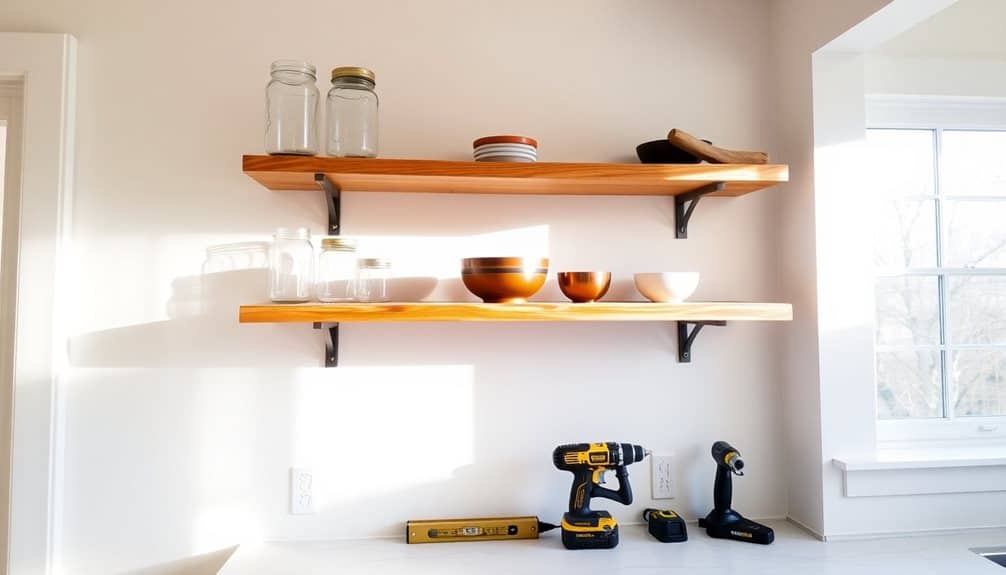
Open shelving transforms your kitchen’s visual appeal while maximizing storage space in a way that complements your newly installed backsplash. To build custom shelves, you’ll need 2×8 lumber boards, heavy-duty brackets, a level, stud finder, power drill, and wood stain or paint of your choice.
Start by marking your desired shelf locations and using the stud finder to locate wall supports. You’ll want to hit at least two studs per shelf for ideal stability. Pre-drill your bracket holes and secure them to the wall using 3-inch wood screws. For a professional finish, consider using a countersink bit to guarantee the screw heads sit flush.
Cut your lumber to size, allowing for a 2-inch overhang on each bracket. Sand the boards thoroughly, progressing from 80-grit to 220-grit sandpaper. Apply your chosen finish in thin, even coats. For moisture resistance, add two coats of polyurethane. Once dry, place the shelves onto the brackets and secure them from underneath using 1-inch screws. Check for level one final time and adjust as needed. Your new open shelving can support up to 75 pounds per linear foot when properly installed. Consider adding a non-slip rubber cover to each shelf surface to prevent items from sliding and protect the wood finish.
Refresh Countertop With Epoxy

Transforming worn countertops with epoxy resin offers a cost-effective alternative to full replacement, giving you a durable, high-gloss finish that can mimic the look of granite or marble. You’ll need to thoroughly clean and sand your existing surface, then apply a primer designed specifically for epoxy adhesion. The careful preparation of your workspace and materials is vital for achieving professional results.
Before beginning the epoxy application process, verify you’ve properly mixed your resin and hardener according to manufacturer specifications. Temperature control in your work area is essential, as it affects cure time and flow characteristics.
- Apply a seal coat first to prevent air bubbles from forming in subsequent layers
- Use a torch or heat gun to pop surface bubbles immediately after pouring
- Work in small sections to maintain control over the self-leveling compound
- Install temporary barriers around edges to prevent epoxy runoff
- Allow complete curing for 72 hours before subjecting to normal use
Once cured, your epoxy countertop will resist scratches, stains, and heat up to 500°F. With proper maintenance, you can expect your renewed surface to last 10-20 years, making it an excellent investment in your kitchen’s functionality and aesthetics. Just like heavy-duty metal stands used in beekeeping, proper annual inspections and maintenance will help ensure your epoxy countertop’s longevity.
Add Rolling Kitchen Island

A rolling kitchen island can revolutionize your workspace by adding flexible storage, prep area, and serving functionality. To build one, you’ll need 3/4-inch plywood for the base structure, 2x4s for internal support, heavy-duty locking casters, and your choice of countertop material.
Start by constructing a basic box frame using the 2x4s, ensuring square corners with a carpenter’s level. Attach plywood panels to create the sides and back, leaving the front open for shelving or drawers. Install interior supports at 12-inch intervals for stability. Mount the casters to a reinforced bottom panel, selecting models rated for at least 75 pounds each.
For storage, incorporate adjustable shelving using shelf pins and brackets. Add a butcher block or laminate countertop, securing it with construction adhesive and screws from underneath. Install cabinet hardware, towel bars, or hooks as needed. Consider adding a drop leaf on one side to maximize space efficiency.
Finish the island with paint, stain, or veneer to match your existing cabinetry. Apply several coats of polyurethane to protect the surface, especially if you’ve chosen a wooden countertop. Secure any joints during assembly using JORGENSEN bar clamps rated for up to 600 pounds of pressure to ensure tight, professional-quality connections.
Frequently Asked Questions
How Long Should I Wait Before Using My Kitchen After DIY Renovations?
You’ll need to wait 24-48 hours after painting or sealing surfaces, 24 hours after grouting tile work, and 72 hours after installing new countertops. If you’ve applied polyurethane to cabinets, wait 48 hours before heavy use. For adhesives and caulking, allow 24 hours to cure fully. Keep windows open for ventilation, and don’t prep food until all materials have completely dried and fumes have dissipated.
What Permits Do I Need for Kitchen Modifications in My Area?
Like traversing a maze, getting the right permits can be tricky. You’ll need to check with your local building department or municipality, as requirements vary by location. Typically, you’ll need permits for structural changes, electrical work, plumbing modifications, or moving gas lines. Create a detailed project plan and bring it to your local permit office. They’ll review your plans and specify which permits you’ll require for compliance.
Can These Projects Be Completed Alone, or Do I Need Help?
While you can tackle many kitchen projects solo, it’s essential to assess each task’s complexity and safety requirements. You’ll want help with heavy lifting, cabinet installations, and any electrical or plumbing work. Keep a partner nearby when using power tools or working on elevated surfaces. Small projects like painting, hardware replacement, or basic tiling can typically be completed alone with proper preparation and tools.
What’s the Average Cost Savings Compared to Hiring Professional Contractors?
While you’ll need to invest in tools and materials upfront, you’ll typically save 50-70% compared to contractor rates of $50-100 per hour. On a standard kitchen backsplash project, you’re looking at $200-300 in DIY costs versus $800-1,200 for professional installation. Cabinet hardware replacement can save you $300-500, and painting cabinets yourself cuts expenses by $1,500-2,000 compared to professional refinishing services.
Which Kitchen Projects Add the Most Value to Home Resale Prices?
Kitchen updates that deliver the highest ROI include cabinet refacing (75-80% return), quality countertop replacements (60-80% return), and modern appliance upgrades (70% return). You’ll maximize value by focusing on your kitchen’s layout efficiency and storage solutions. Installing under-cabinet lighting, updating hardware, and adding a tile backsplash will boost your home’s appeal while keeping costs manageable for a strong return.

